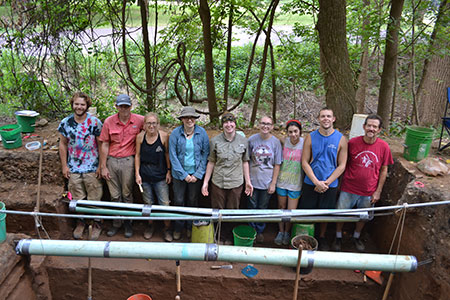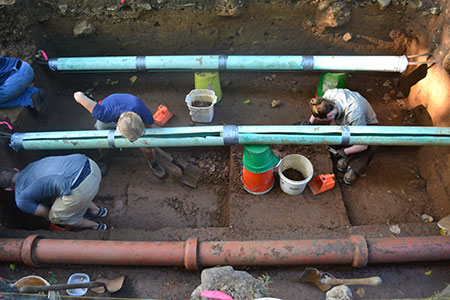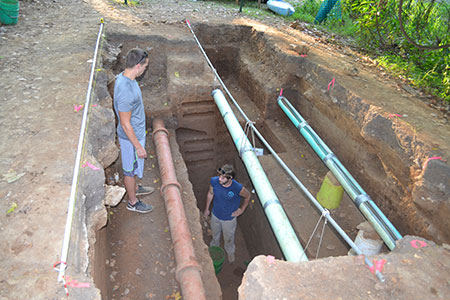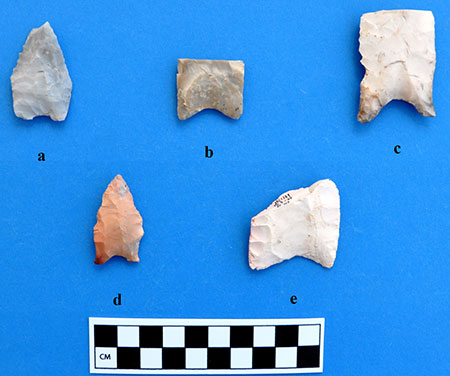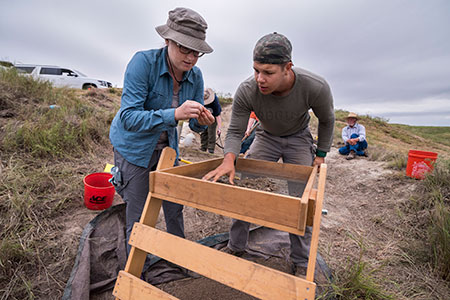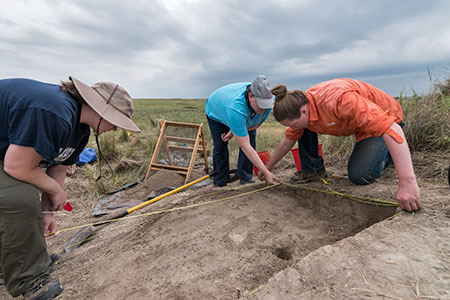Projects—2017
This year Odyssey crews returned to the area of Big Spring in southeast Missouri to conduct test excavations at the Spring Valley site. Also, survey and test excavations at the Classen Ranch locality in southwest Kansas targeted the exposed or near-surface manifestations of the terminal Pleistocene landscape.
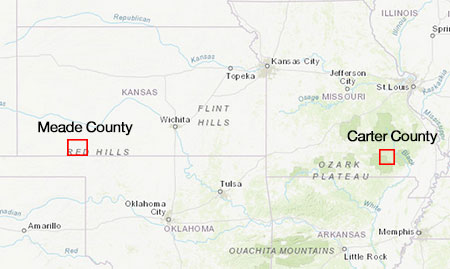
1. Excavations at the Spring Valley site (23CT389) in Carter County, southeastern Missouri
Odyssey turned its attention once again this year to the Missouri Ozarks in the vicinity of Big Spring (Photo 1). With an average flow of 470 cubic feet of water per second, Big Spring is the largest single-outlet spring in the Western Hemisphere, making it an attractive location for human occupation. The area around the site has been heavily disturbed by historic CCC projects and by installation of other infrastructure. The site is located on a co-alluvial fan providing a once stable landform with potential to contain undisturbed buried Paleoindian or pre-Clovis occupations. Odyssey crews, in collaboration with Missouri State University, and under the direction of Jack Hofman (University of Kansas) excavated several test units to a depth of 3 meters below surface (Photo 2) with the goal to determine the integrity of the Late Paleoindian occupation (link to Niquette 2018) and to investigate potential for deeply buried Early Paleoindian or Pre-Clovis deposits (Photo 3). Excavations exposed a thick, intact Dalton (Late Paleoindian) component with abundant chipped stone artifacts, including multiple projectile points (Photo 4). Though not encountered in this year's excavation units, there is evidence of an older Paleoindian occupation at the site. Specifically, a fluted Gainey point was discovered, but natural soil-mixing processes had compromised the stratigraphic integrity of the point.
Photo 1. Odyssey crew and participants from Missouri State University and Washburn University at the Spring Valley site. From left to right: R. Mason Niquette, Josh Collins, Jacque Griffith-Esala, Laura Murphy, Paige Englert, Alyssa Sparks, Mathew Nowak, and Jack Ray.
Photo 2. Odyssey crews excavating Paleoindian occupation layer beneath modern utility lines.
Photo 3. R. Mason Niquette examines the site stratigraphy at Spring Valley for his Master's thesis research.
Photo 4. Diagnostic projectile points recovered during excavations at Spring Valley.
2. Survey and excavations at the Classen Ranch Locality in Meade County, southwestern Kansas
A ten-day session at the Classen Ranch Locality in southwestern Kansas provided the opportunity to explore the area for Pleistocene-aged fauna and archaeological sites. The field team was led by Dr. Laura Murphy (Washburn University) and was comprised of Odyssey crew, Washburn University field school students, and community volunteers. Pedestrian survey, shovel tests and excavation units were all employed in the hunt for remnants of the Pleistocene landscape. Test units were placed in a buried A-Horizon and spring deposits identified in a cutbank exposure along Sand Creek. Chipped stone artifacts, fire-cracked rock, and animal bone were recovered. However, the team did not re-locate a reportedly human-modified mastodon skull exposed and re-buried at Classen Ranch by paleontologists in the 1970s. The search for this figurative needle in the haystack may continue, but for 2017 the research team did all that could be done, including the use of ground-penetrating radar, to re-expose this intriguing specimen.
Photo 1. Laura Murphy and a field school student examine an artifact recovered from a test unit on Sand Creek at the Classen Ranch Locality in Meade County, Kansas. Photo courtesy Doug Stremel.
Photo 2. Odyssey crew member Paige Englert helps Washburn University field school students map the first level of their test unit. Photo courtesy Doug Stremel.
